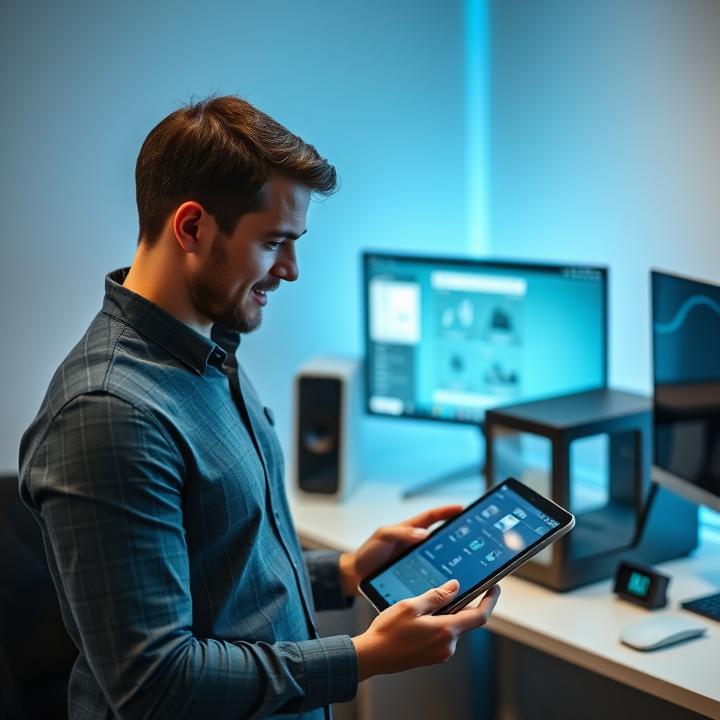The Role of 3D Printing in Product Reviews: How This Technology is Transforming Consumer Insights in 2024

As 3D printing becomes more mainstream in 2024, its role in shaping product reviews and consumer insights is rapidly growing. This article explores how manufacturers and consumers are leveraging 3D printing technology to create accurate prototypes, test products, and enhance the buying experience. From prototype to finished product, discover how 3D printing is revolutionizing product reviews, improving transparency, and driving customer satisfaction.
In 2024, 3D printing will no longer be a cutting-edge innovation; it will evolve into an essential tool for product development, particularly in enhancing the product review process. Traditionally, product reviews have been based on descriptions, images, and user feedback. However, with the integration of 3D printing, the way consumers and companies engage with product evaluations is undergoing a significant transformation. The ability to rapidly prototype, test, and showcase products before they hit the market has created a more transparent and interactive experience for consumers.
In this article, we’ll explore how 3D printing is changing the landscape of product reviews and reshaping how customers make purchasing decisions. From prototype creation to hands-on testing, 3D printing is offering consumers new ways to interact with products before committing to a purchase, ultimately increasing satisfaction and confidence in their buying decisions.
The Rise of 3D Printing in Product Prototyping
Faster, More Efficient Prototyping
One of the most significant impacts of 3D printing on product reviews is in the prototyping phase. In the past, product prototyping involved time-consuming processes, including mold creation, manual assembly, and expensive tooling. With 3D printing, however, manufacturers can rapidly produce prototypes in a fraction of the time and at a significantly lower cost. This not only speeds up the design process but also allows for frequent iterations, meaning that products can be improved in real time based on feedback from initial test users or even customers.
For example, in the automotive industry, manufacturers now utilize 3D printing to produce high-quality prototypes of vehicle parts and accessories. This allows companies to conduct real-world tests with the exact materials that will be used in production, ensuring better performance and durability. By using rapid prototyping, carmakers can address potential issues, refine designs, and ensure a better product experience for customers long before the product reaches the production line.
This acceleration in prototyping has led to more iterative testing. Manufacturers can quickly create models of products, test their functionality, and make design tweaks without the need for expensive tools or molds. As a result, the product development cycle is shortened, allowing consumers to receive products that are more polished and well-tested.
Transparency and Customization for Consumers
With 3D printing, product designers can provide much more transparency in the design and review process. By using 3D-printed prototypes, manufacturers can give consumers early access to models of products. This helps customers visualize and interact with the product in a way that static images or descriptions cannot offer.
For instance, in the fashion industry, some companies have started to use 3D-printed prototypes to allow customers to view potential clothing designs in a virtual showroom. Shoppers can rotate and zoom in on garments, assessing fabric texture and style features as they would in a physical store. By enabling such customization and transparency, 3D printing allows customers to make more informed decisions, knowing that they are purchasing products that meet their exact needs.
Consumers are also becoming more accustomed to personalized products. 3D printing allows for rapid customization, enabling manufacturers to provide tailored versions of products for individual customers. For example, in the fashion industry, customers can see and adjust the design features of clothing or accessories before finalizing their purchase. In other sectors, such as consumer electronics, 3D printing can be used to personalize devices to suit individual preferences, whether it be a case for a smartphone or a set of accessories for a car.
The transparency offered by 3D-printed prototypes also helps in creating more accurate product reviews. Since customers have hands-on experiences with the prototypes, their reviews reflect a genuine understanding of the product’s look, feel, and functionality, rather than relying solely on descriptions or second-hand experiences.
3D-Printed Reviews: How Consumers Are Using 3D Printing to Test Products
The Role of 3D Printing in DIY Testing
With the growing accessibility of 3D printers, more consumers are using the technology to conduct DIY product testing. Whether it’s reviewing a new tech gadget or evaluating a home improvement tool, consumers can now print and test products before making a commitment. For example, a consumer looking to purchase a new piece of furniture might find a 3D-printed version of a component, such as a chair or shelf, to test how it fits in their home or office space.
Instead of relying on traditional product reviews alone, consumers can now create 3D models of products and test their features firsthand. For example, a tech enthusiast might use 3D printing to test smartphone accessories such as charging docks or cases before purchasing the official version. This ability to customize and print products based on specific needs allows users to assess how well they work in their personal context, providing a more thorough review process.
This not only allows consumers to evaluate a product’s functionality firsthand but also to ensure that it aligns with their specific needs before purchasing. Additionally, 3D printing can be used to produce accessories or replacement parts for products. If a consumer finds a product missing a feature or requiring modification, they may print their own 3D parts to complete the item. This personalized testing experience ensures a higher level of satisfaction and minimizes the likelihood of returning products after purchase.
The practice of 3D printing product prototypes for review gives consumers the ability to evaluate a product on their terms, promoting a deeper understanding of what they’re purchasing. This level of interaction elevates product reviews from mere feedback to comprehensive evaluations based on tangible testing.
Increasing Product Review Transparency
For companies, 3D printing helps create greater transparency in their product reviews. Rather than relying solely on written descriptions, companies can share physical 3D models of their products with reviewers. This allows reviewers to interact with the product more thoroughly and report on its functionality in a way that written reviews or images alone cannot.
For instance, in the toy industry, 3D-printed models of toys could be sent to influencers or testers, allowing them to assess product durability, design, and safety before publicly sharing their thoughts. The combination of physical interaction and detailed feedback based on firsthand experience creates more reliable and transparent reviews, which consumers value when making buying decisions.
Moreover, consumers are starting to demand greater authenticity in product reviews, especially when it comes to high-value or high-risk items such as electronics, furniture, or vehicles. 3D printing allows for a new level of transparency by providing tangible, physical evidence of how a product performs in real life. This helps potential buyers make more informed choices based on genuine, in-depth reviews.
The Benefits of 3D Printing in Product Development and Market Feedback
Gaining Consumer Insights Through Prototypes
As 3D printing enables faster prototyping, companies can gather market feedback earlier in the product development process. Instead of waiting for a final version of a product to hit the shelves, manufacturers can use 3D-printed prototypes to gauge customer interest and gather insights. Focus groups or even early adopter consumers can engage with these prototypes, providing valuable feedback that may lead to design refinements or changes before the official product release.
This feedback is essential for manufacturers, as it allows them to fine-tune product designs based on real consumer opinions. For example, a company designing a new smartwatch could use 3D printing to create prototype models and distribute them to select reviewers or customers. These individuals can then provide insights into the product’s ergonomics, design, and usability, leading to meaningful improvements before mass production.
By allowing customers to provide input on a product’s form, function, and usability during the prototyping phase, companies can ensure that the final product is more likely to meet market expectations. This iterative design process helps prevent product failures and reduces the risk of launching items that don’t align with consumer preferences.
Real-Time Product Improvements Based on Feedback
In the world of 3D printing, product reviews don’t just happen after a product is released to the public. Manufacturers can use rapid prototyping and the feedback generated by consumer reviews to make real-time improvements to products, even before they are mass-produced. For example, if an initial batch of prototypes reveals design flaws or functionality issues, companies can quickly modify and refine the design based on consumer feedback before mass production begins.
This speed and flexibility allow businesses to be more responsive to market needs and demands, ensuring that the products that ultimately reach the consumer are refined and optimized for success. 3D printing makes this process much faster and more affordable than traditional manufacturing methods, enabling companies to adjust their products on the fly based on direct consumer feedback.
The ability to iterate designs rapidly based on feedback from product reviews not only accelerates the development cycle but also improves overall product quality. With 3D printing, product designs are continually honed, ensuring a higher level of satisfaction when the final product is released to the market.
3D Printing and the Future of Product Reviews
A Shift Toward More Interactive, Personalized Product Evaluations
Looking ahead, the role of 3D printing in product reviews will continue to evolve. As consumers become more accustomed to the idea of interacting with products before purchasing them, we can expect to see even greater shifts toward personalization in the review process. Instead of relying on traditional forms of product reviews, companies may soon offer customized 3D-printed versions of their products to reviewers, who can then test the functionality in their own environments.
Additionally, augmented reality (AR) and virtual reality (VR) technologies could be integrated into the 3D printing process, allowing consumers to visualize products in 3D before they even print them. For example, a customer could use a VR headset to see a 3D model of a product in their home environment and then choose to print it for a hands-on review. This integration of 3D printing with immersive technologies would provide an even more interactive and engaging product review experience.
The future of product reviews will likely involve greater levels of immersion and personalization. As 3D printing becomes even more integrated with emerging technologies, consumers will have the ability to test, modify, and review products in more dynamic ways, making reviews an even more integral part of the purchasing process.
H3: Consumer-Driven Product Innovation
As 3D printing becomes more accessible, consumers will likely play an even more significant role in shaping product development and reviews. The ability to print, test, and modify products at home will give consumers unprecedented influence in product innovation. In the future, customers could potentially design their own variations of products based on existing models and share their feedback, leading to a more collaborative approach to product development.
This democratization of product design could result in an even greater shift toward personalization, where consumers not only review products but actively participate in shaping their features. With 3D printing, manufacturers will have access to a wealth of data and insights that can be used to continuously improve and personalize their offerings, creating a more consumer-centric approach to product innovation.
3D printing is rapidly transforming how consumers engage with product reviews. By enabling faster prototyping, real-time testing, and greater transparency, this technology has introduced new opportunities for both manufacturers and consumers to interact with products in more meaningful ways. From personalized reviews to consumer-driven innovation, the possibilities for the future of product evaluations are endless. As we move forward, it’s clear that 3D printing will continue to play an integral role in shaping how we assess, customize, and purchase products in 2024 and beyond.






